Detailed Solution and Analysis: Economics and Business Environment
VerifiedAdded on 2023/01/09
|12
|2947
|2
Homework Assignment
AI Summary
This economics assignment solution delves into various aspects of the business environment. Question 1 analyzes profit maximization under monopolistic competition, calculating profit, total revenue, and total cost. It also explores the impact of new firms entering the market. Question 2 examines government policies, including corrective taxes and free education, assessing their implications on consumer behavior, economic efficiency, and labor markets. Question 3 addresses macroeconomic concepts, calculating equilibrium income, the impact of government spending, and the multiplier effect. Finally, Question 4 compares and contrasts fiscal and monetary policies, highlighting their strengths and weaknesses in achieving economic objectives such as unemployment reduction, budget deficit reduction, and economic growth, and their impact on investment and political freedom. This assignment provides a comprehensive overview of key economic principles and their practical applications.
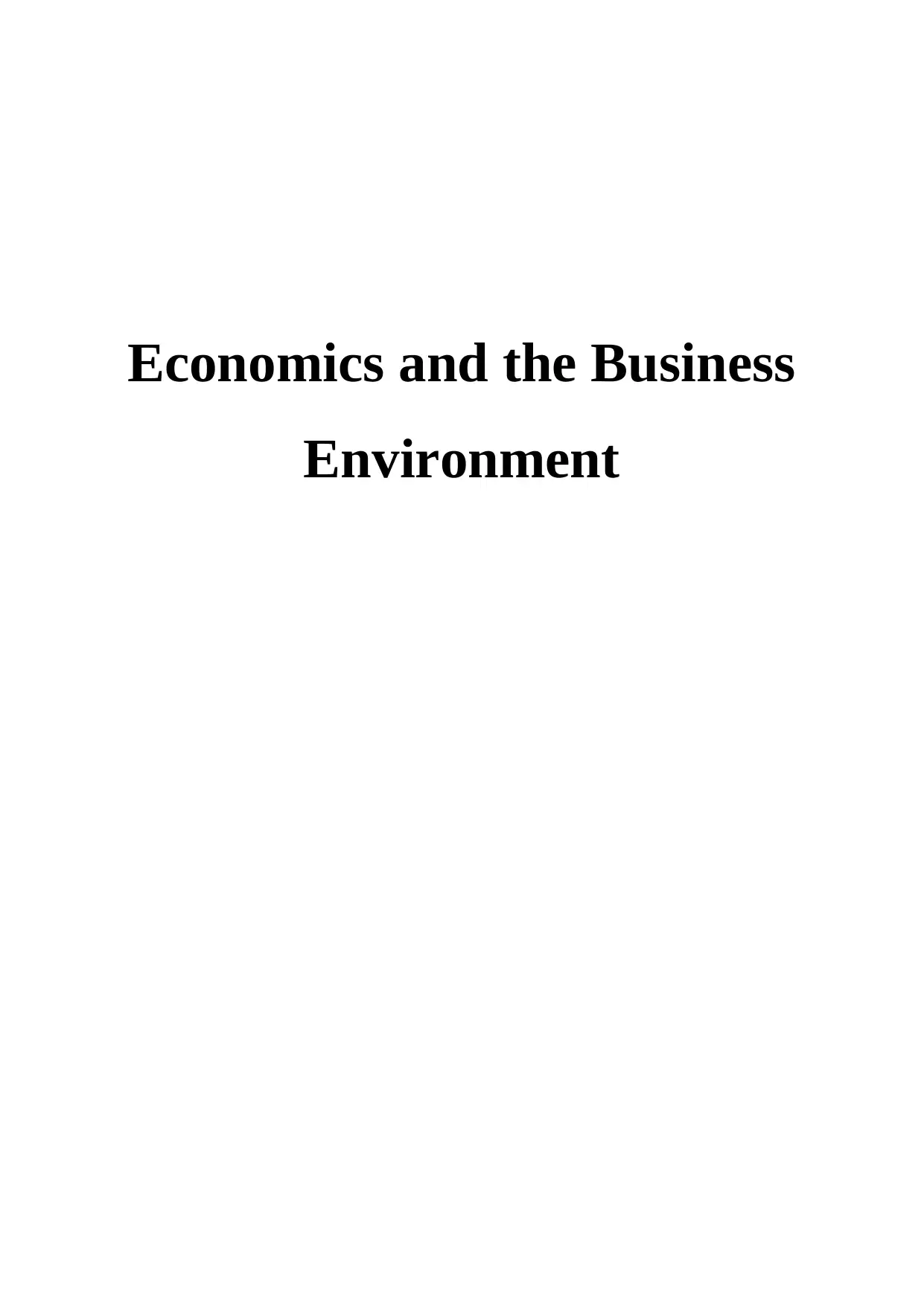
Economics and the Business
Environment
Environment
Paraphrase This Document
Need a fresh take? Get an instant paraphrase of this document with our AI Paraphraser
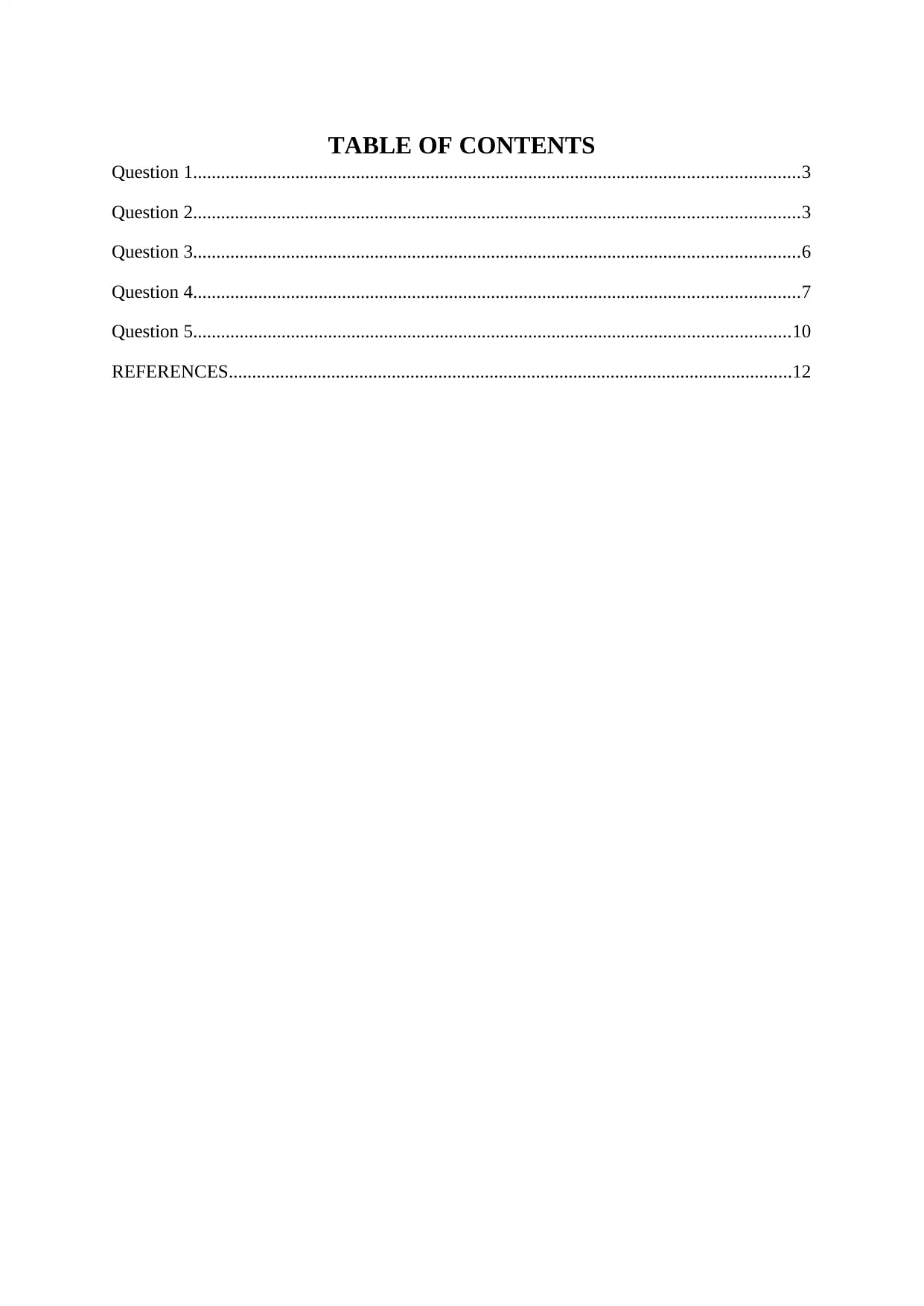
TABLE OF CONTENTS
Question 1..................................................................................................................................3
Question 2..................................................................................................................................3
Question 3..................................................................................................................................6
Question 4..................................................................................................................................7
Question 5................................................................................................................................10
REFERENCES.........................................................................................................................12
Question 1..................................................................................................................................3
Question 2..................................................................................................................................3
Question 3..................................................................................................................................6
Question 4..................................................................................................................................7
Question 5................................................................................................................................10
REFERENCES.........................................................................................................................12
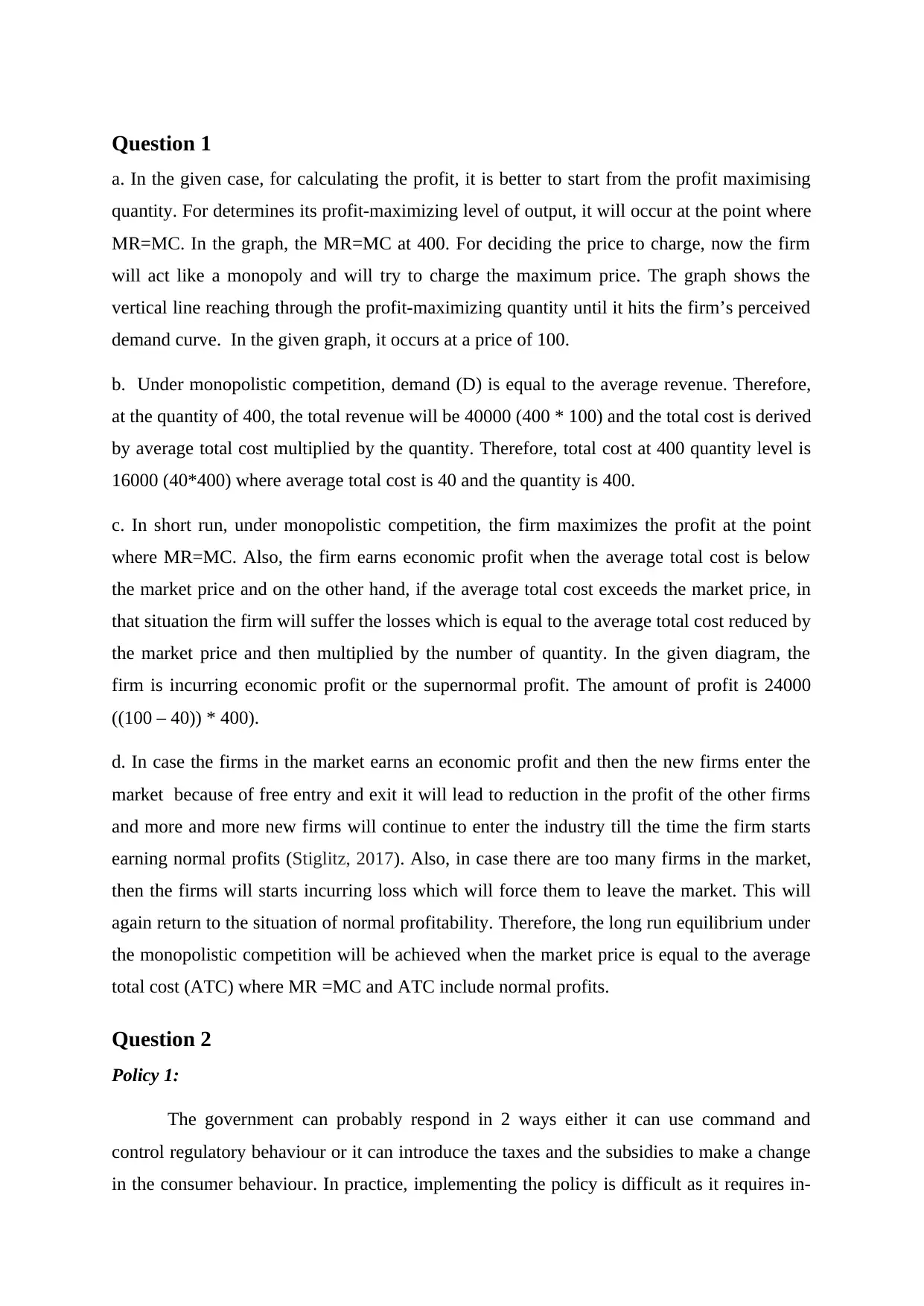
Question 1
a. In the given case, for calculating the profit, it is better to start from the profit maximising
quantity. For determines its profit-maximizing level of output, it will occur at the point where
MR=MC. In the graph, the MR=MC at 400. For deciding the price to charge, now the firm
will act like a monopoly and will try to charge the maximum price. The graph shows the
vertical line reaching through the profit-maximizing quantity until it hits the firm’s perceived
demand curve. In the given graph, it occurs at a price of 100.
b. Under monopolistic competition, demand (D) is equal to the average revenue. Therefore,
at the quantity of 400, the total revenue will be 40000 (400 * 100) and the total cost is derived
by average total cost multiplied by the quantity. Therefore, total cost at 400 quantity level is
16000 (40*400) where average total cost is 40 and the quantity is 400.
c. In short run, under monopolistic competition, the firm maximizes the profit at the point
where MR=MC. Also, the firm earns economic profit when the average total cost is below
the market price and on the other hand, if the average total cost exceeds the market price, in
that situation the firm will suffer the losses which is equal to the average total cost reduced by
the market price and then multiplied by the number of quantity. In the given diagram, the
firm is incurring economic profit or the supernormal profit. The amount of profit is 24000
((100 – 40)) * 400).
d. In case the firms in the market earns an economic profit and then the new firms enter the
market because of free entry and exit it will lead to reduction in the profit of the other firms
and more and more new firms will continue to enter the industry till the time the firm starts
earning normal profits (Stiglitz, 2017). Also, in case there are too many firms in the market,
then the firms will starts incurring loss which will force them to leave the market. This will
again return to the situation of normal profitability. Therefore, the long run equilibrium under
the monopolistic competition will be achieved when the market price is equal to the average
total cost (ATC) where MR =MC and ATC include normal profits.
Question 2
Policy 1:
The government can probably respond in 2 ways either it can use command and
control regulatory behaviour or it can introduce the taxes and the subsidies to make a change
in the consumer behaviour. In practice, implementing the policy is difficult as it requires in-
a. In the given case, for calculating the profit, it is better to start from the profit maximising
quantity. For determines its profit-maximizing level of output, it will occur at the point where
MR=MC. In the graph, the MR=MC at 400. For deciding the price to charge, now the firm
will act like a monopoly and will try to charge the maximum price. The graph shows the
vertical line reaching through the profit-maximizing quantity until it hits the firm’s perceived
demand curve. In the given graph, it occurs at a price of 100.
b. Under monopolistic competition, demand (D) is equal to the average revenue. Therefore,
at the quantity of 400, the total revenue will be 40000 (400 * 100) and the total cost is derived
by average total cost multiplied by the quantity. Therefore, total cost at 400 quantity level is
16000 (40*400) where average total cost is 40 and the quantity is 400.
c. In short run, under monopolistic competition, the firm maximizes the profit at the point
where MR=MC. Also, the firm earns economic profit when the average total cost is below
the market price and on the other hand, if the average total cost exceeds the market price, in
that situation the firm will suffer the losses which is equal to the average total cost reduced by
the market price and then multiplied by the number of quantity. In the given diagram, the
firm is incurring economic profit or the supernormal profit. The amount of profit is 24000
((100 – 40)) * 400).
d. In case the firms in the market earns an economic profit and then the new firms enter the
market because of free entry and exit it will lead to reduction in the profit of the other firms
and more and more new firms will continue to enter the industry till the time the firm starts
earning normal profits (Stiglitz, 2017). Also, in case there are too many firms in the market,
then the firms will starts incurring loss which will force them to leave the market. This will
again return to the situation of normal profitability. Therefore, the long run equilibrium under
the monopolistic competition will be achieved when the market price is equal to the average
total cost (ATC) where MR =MC and ATC include normal profits.
Question 2
Policy 1:
The government can probably respond in 2 ways either it can use command and
control regulatory behaviour or it can introduce the taxes and the subsidies to make a change
in the consumer behaviour. In practice, implementing the policy is difficult as it requires in-
⊘ This is a preview!⊘
Do you want full access?
Subscribe today to unlock all pages.

Trusted by 1+ million students worldwide
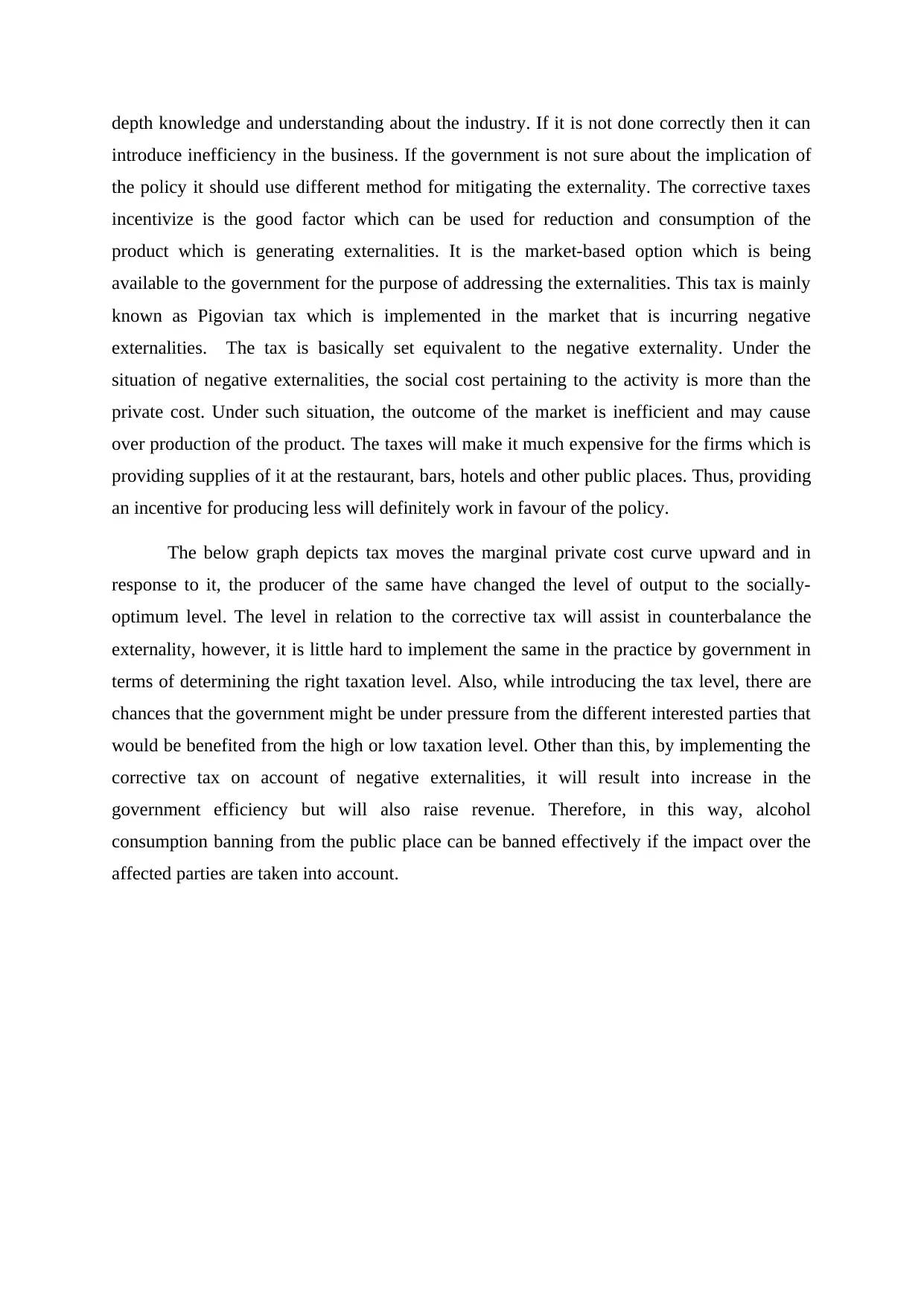
depth knowledge and understanding about the industry. If it is not done correctly then it can
introduce inefficiency in the business. If the government is not sure about the implication of
the policy it should use different method for mitigating the externality. The corrective taxes
incentivize is the good factor which can be used for reduction and consumption of the
product which is generating externalities. It is the market-based option which is being
available to the government for the purpose of addressing the externalities. This tax is mainly
known as Pigovian tax which is implemented in the market that is incurring negative
externalities. The tax is basically set equivalent to the negative externality. Under the
situation of negative externalities, the social cost pertaining to the activity is more than the
private cost. Under such situation, the outcome of the market is inefficient and may cause
over production of the product. The taxes will make it much expensive for the firms which is
providing supplies of it at the restaurant, bars, hotels and other public places. Thus, providing
an incentive for producing less will definitely work in favour of the policy.
The below graph depicts tax moves the marginal private cost curve upward and in
response to it, the producer of the same have changed the level of output to the socially-
optimum level. The level in relation to the corrective tax will assist in counterbalance the
externality, however, it is little hard to implement the same in the practice by government in
terms of determining the right taxation level. Also, while introducing the tax level, there are
chances that the government might be under pressure from the different interested parties that
would be benefited from the high or low taxation level. Other than this, by implementing the
corrective tax on account of negative externalities, it will result into increase in the
government efficiency but will also raise revenue. Therefore, in this way, alcohol
consumption banning from the public place can be banned effectively if the impact over the
affected parties are taken into account.
introduce inefficiency in the business. If the government is not sure about the implication of
the policy it should use different method for mitigating the externality. The corrective taxes
incentivize is the good factor which can be used for reduction and consumption of the
product which is generating externalities. It is the market-based option which is being
available to the government for the purpose of addressing the externalities. This tax is mainly
known as Pigovian tax which is implemented in the market that is incurring negative
externalities. The tax is basically set equivalent to the negative externality. Under the
situation of negative externalities, the social cost pertaining to the activity is more than the
private cost. Under such situation, the outcome of the market is inefficient and may cause
over production of the product. The taxes will make it much expensive for the firms which is
providing supplies of it at the restaurant, bars, hotels and other public places. Thus, providing
an incentive for producing less will definitely work in favour of the policy.
The below graph depicts tax moves the marginal private cost curve upward and in
response to it, the producer of the same have changed the level of output to the socially-
optimum level. The level in relation to the corrective tax will assist in counterbalance the
externality, however, it is little hard to implement the same in the practice by government in
terms of determining the right taxation level. Also, while introducing the tax level, there are
chances that the government might be under pressure from the different interested parties that
would be benefited from the high or low taxation level. Other than this, by implementing the
corrective tax on account of negative externalities, it will result into increase in the
government efficiency but will also raise revenue. Therefore, in this way, alcohol
consumption banning from the public place can be banned effectively if the impact over the
affected parties are taken into account.
Paraphrase This Document
Need a fresh take? Get an instant paraphrase of this document with our AI Paraphraser
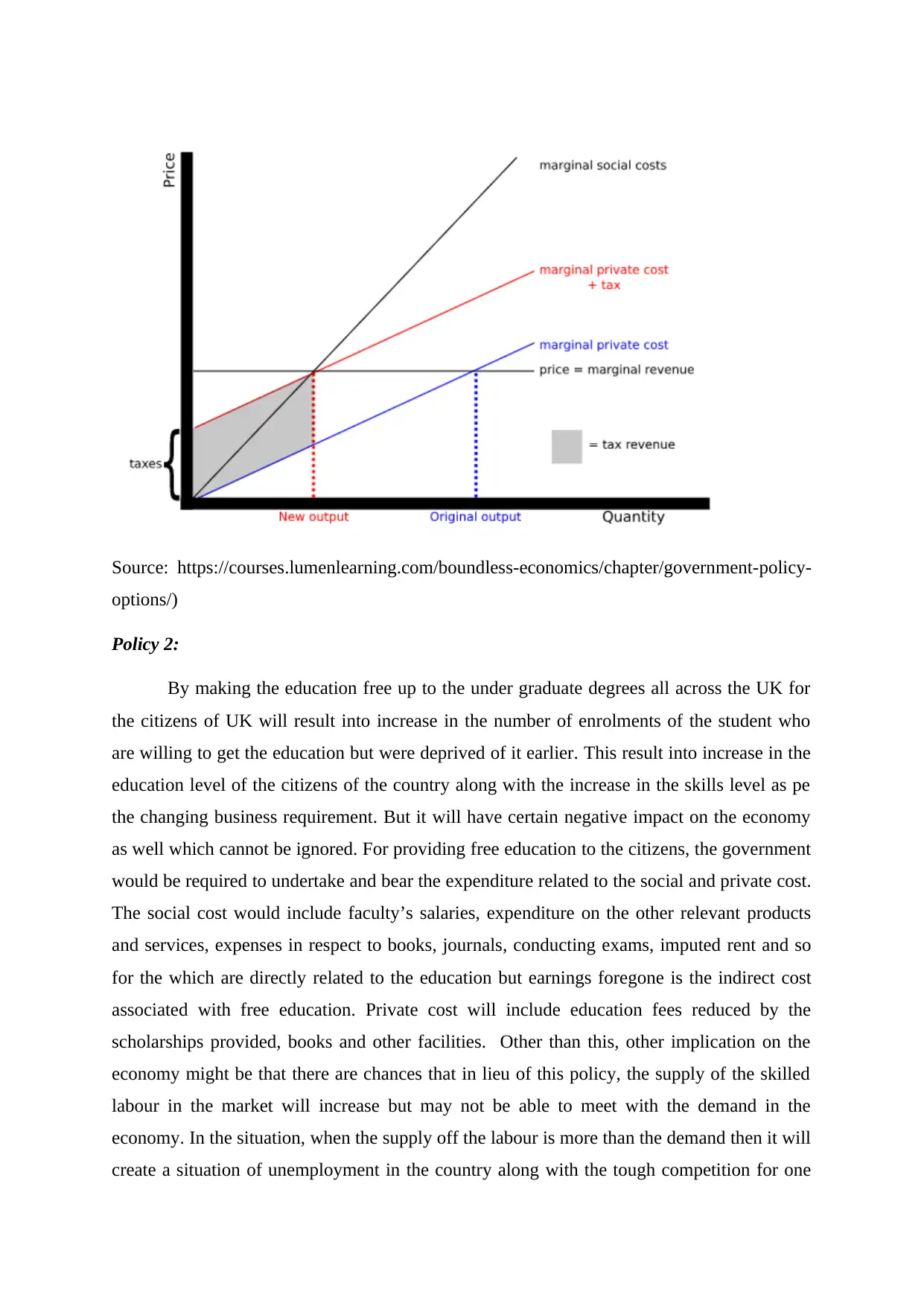
Source: https://courses.lumenlearning.com/boundless-economics/chapter/government-policy-
options/)
Policy 2:
By making the education free up to the under graduate degrees all across the UK for
the citizens of UK will result into increase in the number of enrolments of the student who
are willing to get the education but were deprived of it earlier. This result into increase in the
education level of the citizens of the country along with the increase in the skills level as pe
the changing business requirement. But it will have certain negative impact on the economy
as well which cannot be ignored. For providing free education to the citizens, the government
would be required to undertake and bear the expenditure related to the social and private cost.
The social cost would include faculty’s salaries, expenditure on the other relevant products
and services, expenses in respect to books, journals, conducting exams, imputed rent and so
for the which are directly related to the education but earnings foregone is the indirect cost
associated with free education. Private cost will include education fees reduced by the
scholarships provided, books and other facilities. Other than this, other implication on the
economy might be that there are chances that in lieu of this policy, the supply of the skilled
labour in the market will increase but may not be able to meet with the demand in the
economy. In the situation, when the supply off the labour is more than the demand then it will
create a situation of unemployment in the country along with the tough competition for one
options/)
Policy 2:
By making the education free up to the under graduate degrees all across the UK for
the citizens of UK will result into increase in the number of enrolments of the student who
are willing to get the education but were deprived of it earlier. This result into increase in the
education level of the citizens of the country along with the increase in the skills level as pe
the changing business requirement. But it will have certain negative impact on the economy
as well which cannot be ignored. For providing free education to the citizens, the government
would be required to undertake and bear the expenditure related to the social and private cost.
The social cost would include faculty’s salaries, expenditure on the other relevant products
and services, expenses in respect to books, journals, conducting exams, imputed rent and so
for the which are directly related to the education but earnings foregone is the indirect cost
associated with free education. Private cost will include education fees reduced by the
scholarships provided, books and other facilities. Other than this, other implication on the
economy might be that there are chances that in lieu of this policy, the supply of the skilled
labour in the market will increase but may not be able to meet with the demand in the
economy. In the situation, when the supply off the labour is more than the demand then it will
create a situation of unemployment in the country along with the tough competition for one
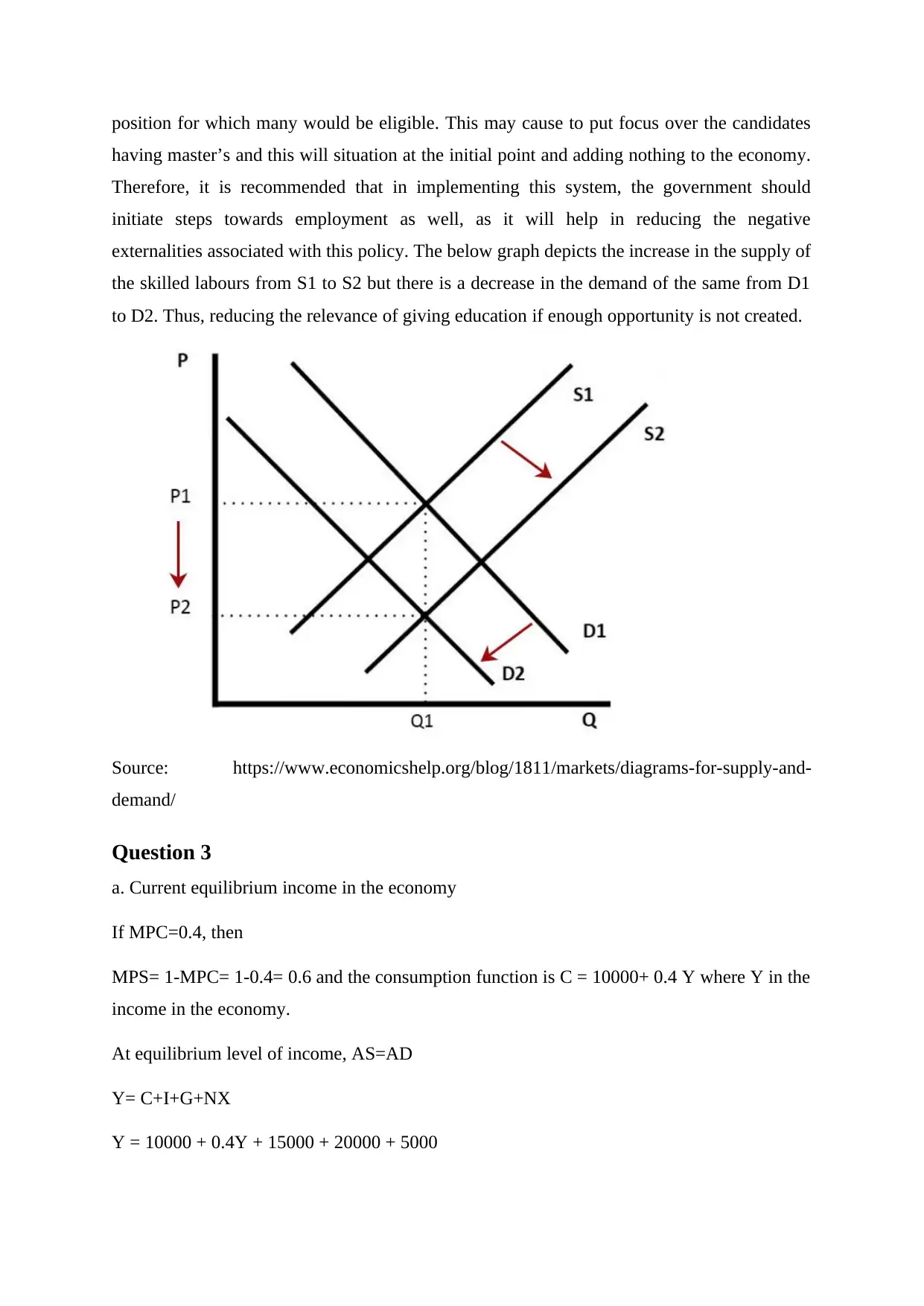
position for which many would be eligible. This may cause to put focus over the candidates
having master’s and this will situation at the initial point and adding nothing to the economy.
Therefore, it is recommended that in implementing this system, the government should
initiate steps towards employment as well, as it will help in reducing the negative
externalities associated with this policy. The below graph depicts the increase in the supply of
the skilled labours from S1 to S2 but there is a decrease in the demand of the same from D1
to D2. Thus, reducing the relevance of giving education if enough opportunity is not created.
Source: https://www.economicshelp.org/blog/1811/markets/diagrams-for-supply-and-
demand/
Question 3
a. Current equilibrium income in the economy
If MPC=0.4, then
MPS= 1-MPC= 1-0.4= 0.6 and the consumption function is C = 10000+ 0.4 Y where Y in the
income in the economy.
At equilibrium level of income, AS=AD
Y= C+I+G+NX
Y = 10000 + 0.4Y + 15000 + 20000 + 5000
having master’s and this will situation at the initial point and adding nothing to the economy.
Therefore, it is recommended that in implementing this system, the government should
initiate steps towards employment as well, as it will help in reducing the negative
externalities associated with this policy. The below graph depicts the increase in the supply of
the skilled labours from S1 to S2 but there is a decrease in the demand of the same from D1
to D2. Thus, reducing the relevance of giving education if enough opportunity is not created.
Source: https://www.economicshelp.org/blog/1811/markets/diagrams-for-supply-and-
demand/
Question 3
a. Current equilibrium income in the economy
If MPC=0.4, then
MPS= 1-MPC= 1-0.4= 0.6 and the consumption function is C = 10000+ 0.4 Y where Y in the
income in the economy.
At equilibrium level of income, AS=AD
Y= C+I+G+NX
Y = 10000 + 0.4Y + 15000 + 20000 + 5000
⊘ This is a preview!⊘
Do you want full access?
Subscribe today to unlock all pages.

Trusted by 1+ million students worldwide
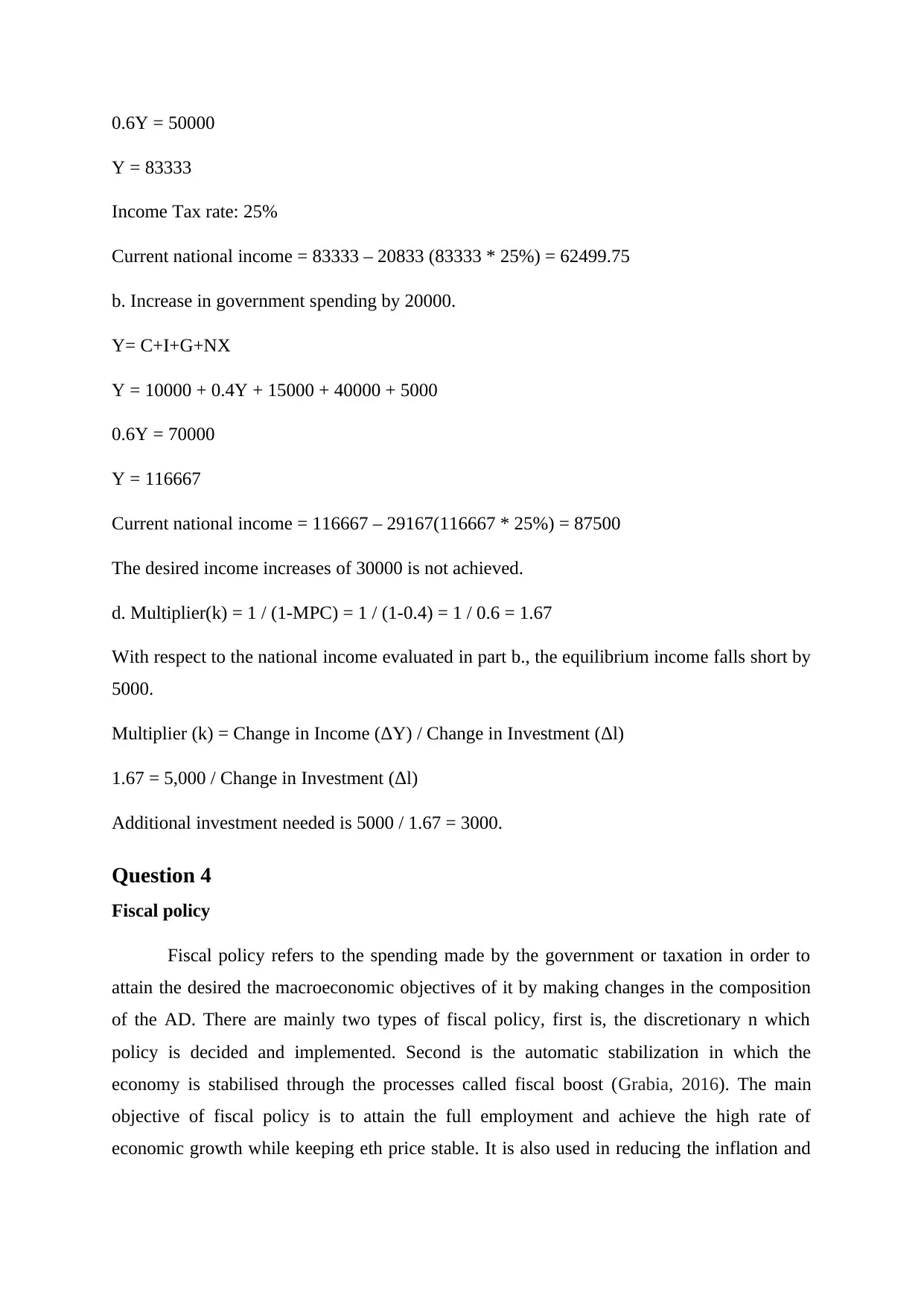
0.6Y = 50000
Y = 83333
Income Tax rate: 25%
Current national income = 83333 – 20833 (83333 * 25%) = 62499.75
b. Increase in government spending by 20000.
Y= C+I+G+NX
Y = 10000 + 0.4Y + 15000 + 40000 + 5000
0.6Y = 70000
Y = 116667
Current national income = 116667 – 29167(116667 * 25%) = 87500
The desired income increases of 30000 is not achieved.
d. Multiplier(k) = 1 / (1-MPC) = 1 / (1-0.4) = 1 / 0.6 = 1.67
With respect to the national income evaluated in part b., the equilibrium income falls short by
5000.
Multiplier (k) = Change in Income (ΔY) / Change in Investment (Δl)
1.67 = 5,000 / Change in Investment (Δl)
Additional investment needed is 5000 / 1.67 = 3000.
Question 4
Fiscal policy
Fiscal policy refers to the spending made by the government or taxation in order to
attain the desired the macroeconomic objectives of it by making changes in the composition
of the AD. There are mainly two types of fiscal policy, first is, the discretionary n which
policy is decided and implemented. Second is the automatic stabilization in which the
economy is stabilised through the processes called fiscal boost (Grabia, 2016). The main
objective of fiscal policy is to attain the full employment and achieve the high rate of
economic growth while keeping eth price stable. It is also used in reducing the inflation and
Y = 83333
Income Tax rate: 25%
Current national income = 83333 – 20833 (83333 * 25%) = 62499.75
b. Increase in government spending by 20000.
Y= C+I+G+NX
Y = 10000 + 0.4Y + 15000 + 40000 + 5000
0.6Y = 70000
Y = 116667
Current national income = 116667 – 29167(116667 * 25%) = 87500
The desired income increases of 30000 is not achieved.
d. Multiplier(k) = 1 / (1-MPC) = 1 / (1-0.4) = 1 / 0.6 = 1.67
With respect to the national income evaluated in part b., the equilibrium income falls short by
5000.
Multiplier (k) = Change in Income (ΔY) / Change in Investment (Δl)
1.67 = 5,000 / Change in Investment (Δl)
Additional investment needed is 5000 / 1.67 = 3000.
Question 4
Fiscal policy
Fiscal policy refers to the spending made by the government or taxation in order to
attain the desired the macroeconomic objectives of it by making changes in the composition
of the AD. There are mainly two types of fiscal policy, first is, the discretionary n which
policy is decided and implemented. Second is the automatic stabilization in which the
economy is stabilised through the processes called fiscal boost (Grabia, 2016). The main
objective of fiscal policy is to attain the full employment and achieve the high rate of
economic growth while keeping eth price stable. It is also used in reducing the inflation and
Paraphrase This Document
Need a fresh take? Get an instant paraphrase of this document with our AI Paraphraser
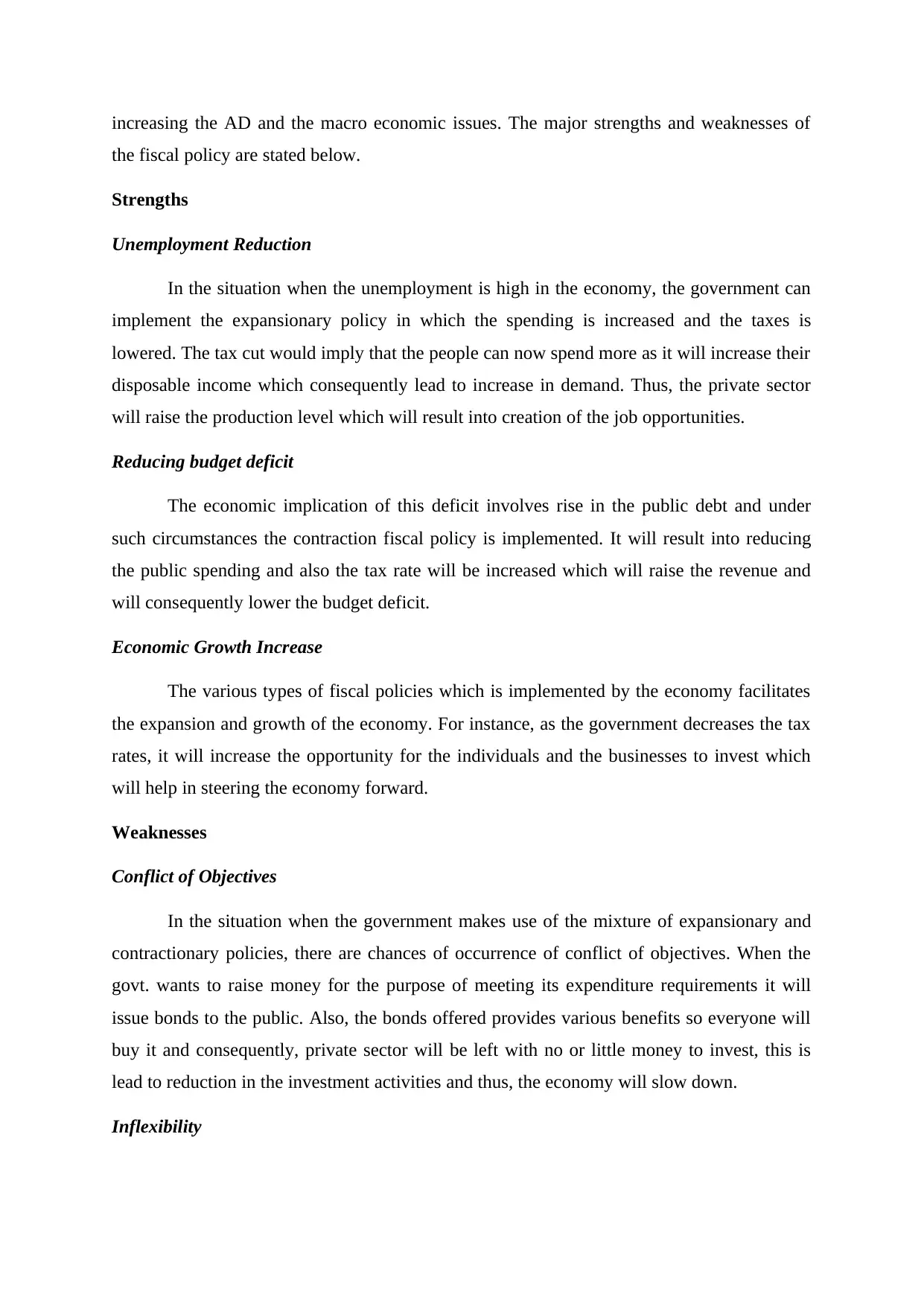
increasing the AD and the macro economic issues. The major strengths and weaknesses of
the fiscal policy are stated below.
Strengths
Unemployment Reduction
In the situation when the unemployment is high in the economy, the government can
implement the expansionary policy in which the spending is increased and the taxes is
lowered. The tax cut would imply that the people can now spend more as it will increase their
disposable income which consequently lead to increase in demand. Thus, the private sector
will raise the production level which will result into creation of the job opportunities.
Reducing budget deficit
The economic implication of this deficit involves rise in the public debt and under
such circumstances the contraction fiscal policy is implemented. It will result into reducing
the public spending and also the tax rate will be increased which will raise the revenue and
will consequently lower the budget deficit.
Economic Growth Increase
The various types of fiscal policies which is implemented by the economy facilitates
the expansion and growth of the economy. For instance, as the government decreases the tax
rates, it will increase the opportunity for the individuals and the businesses to invest which
will help in steering the economy forward.
Weaknesses
Conflict of Objectives
In the situation when the government makes use of the mixture of expansionary and
contractionary policies, there are chances of occurrence of conflict of objectives. When the
govt. wants to raise money for the purpose of meeting its expenditure requirements it will
issue bonds to the public. Also, the bonds offered provides various benefits so everyone will
buy it and consequently, private sector will be left with no or little money to invest, this is
lead to reduction in the investment activities and thus, the economy will slow down.
Inflexibility
the fiscal policy are stated below.
Strengths
Unemployment Reduction
In the situation when the unemployment is high in the economy, the government can
implement the expansionary policy in which the spending is increased and the taxes is
lowered. The tax cut would imply that the people can now spend more as it will increase their
disposable income which consequently lead to increase in demand. Thus, the private sector
will raise the production level which will result into creation of the job opportunities.
Reducing budget deficit
The economic implication of this deficit involves rise in the public debt and under
such circumstances the contraction fiscal policy is implemented. It will result into reducing
the public spending and also the tax rate will be increased which will raise the revenue and
will consequently lower the budget deficit.
Economic Growth Increase
The various types of fiscal policies which is implemented by the economy facilitates
the expansion and growth of the economy. For instance, as the government decreases the tax
rates, it will increase the opportunity for the individuals and the businesses to invest which
will help in steering the economy forward.
Weaknesses
Conflict of Objectives
In the situation when the government makes use of the mixture of expansionary and
contractionary policies, there are chances of occurrence of conflict of objectives. When the
govt. wants to raise money for the purpose of meeting its expenditure requirements it will
issue bonds to the public. Also, the bonds offered provides various benefits so everyone will
buy it and consequently, private sector will be left with no or little money to invest, this is
lead to reduction in the investment activities and thus, the economy will slow down.
Inflexibility
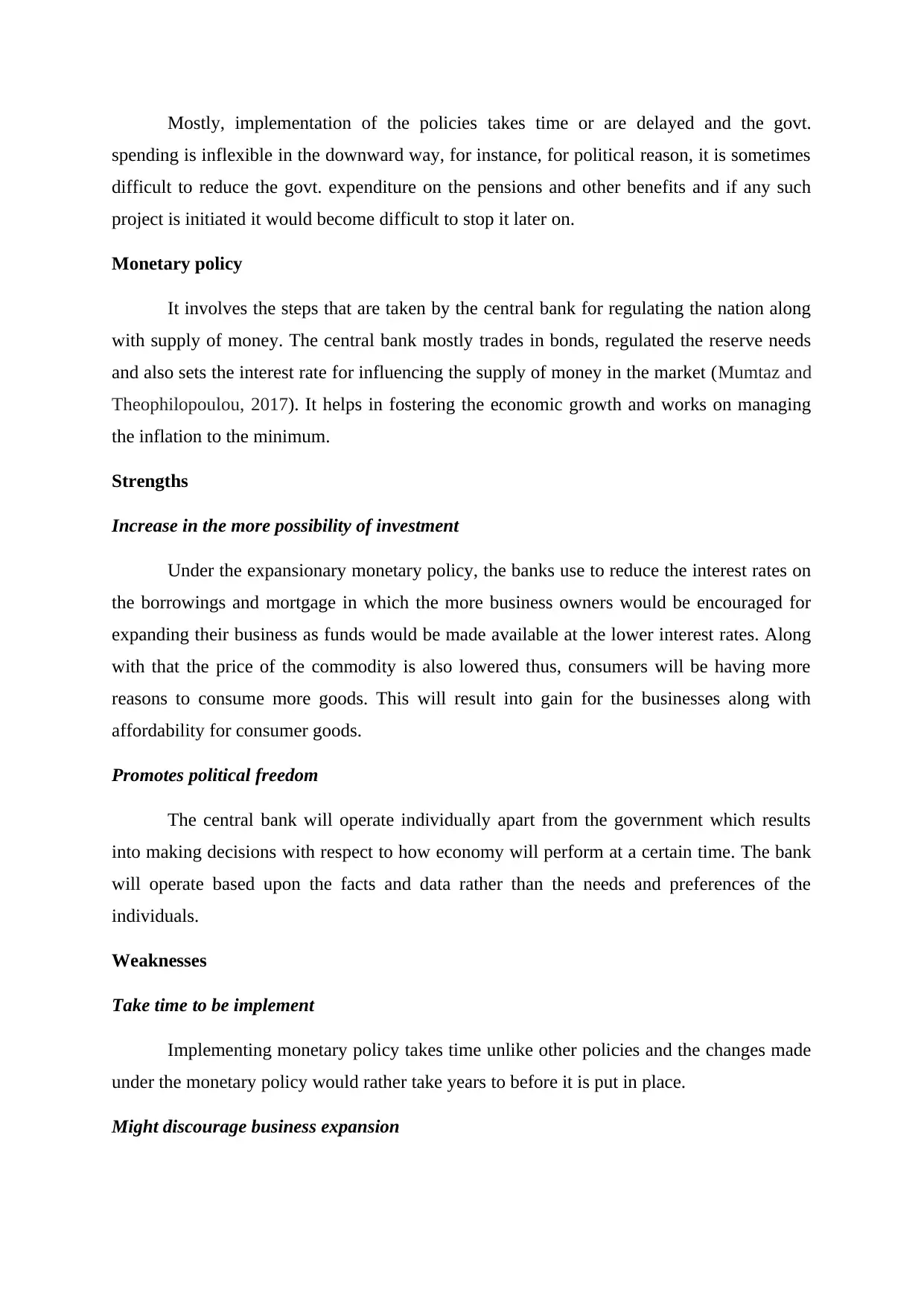
Mostly, implementation of the policies takes time or are delayed and the govt.
spending is inflexible in the downward way, for instance, for political reason, it is sometimes
difficult to reduce the govt. expenditure on the pensions and other benefits and if any such
project is initiated it would become difficult to stop it later on.
Monetary policy
It involves the steps that are taken by the central bank for regulating the nation along
with supply of money. The central bank mostly trades in bonds, regulated the reserve needs
and also sets the interest rate for influencing the supply of money in the market (Mumtaz and
Theophilopoulou, 2017). It helps in fostering the economic growth and works on managing
the inflation to the minimum.
Strengths
Increase in the more possibility of investment
Under the expansionary monetary policy, the banks use to reduce the interest rates on
the borrowings and mortgage in which the more business owners would be encouraged for
expanding their business as funds would be made available at the lower interest rates. Along
with that the price of the commodity is also lowered thus, consumers will be having more
reasons to consume more goods. This will result into gain for the businesses along with
affordability for consumer goods.
Promotes political freedom
The central bank will operate individually apart from the government which results
into making decisions with respect to how economy will perform at a certain time. The bank
will operate based upon the facts and data rather than the needs and preferences of the
individuals.
Weaknesses
Take time to be implement
Implementing monetary policy takes time unlike other policies and the changes made
under the monetary policy would rather take years to before it is put in place.
Might discourage business expansion
spending is inflexible in the downward way, for instance, for political reason, it is sometimes
difficult to reduce the govt. expenditure on the pensions and other benefits and if any such
project is initiated it would become difficult to stop it later on.
Monetary policy
It involves the steps that are taken by the central bank for regulating the nation along
with supply of money. The central bank mostly trades in bonds, regulated the reserve needs
and also sets the interest rate for influencing the supply of money in the market (Mumtaz and
Theophilopoulou, 2017). It helps in fostering the economic growth and works on managing
the inflation to the minimum.
Strengths
Increase in the more possibility of investment
Under the expansionary monetary policy, the banks use to reduce the interest rates on
the borrowings and mortgage in which the more business owners would be encouraged for
expanding their business as funds would be made available at the lower interest rates. Along
with that the price of the commodity is also lowered thus, consumers will be having more
reasons to consume more goods. This will result into gain for the businesses along with
affordability for consumer goods.
Promotes political freedom
The central bank will operate individually apart from the government which results
into making decisions with respect to how economy will perform at a certain time. The bank
will operate based upon the facts and data rather than the needs and preferences of the
individuals.
Weaknesses
Take time to be implement
Implementing monetary policy takes time unlike other policies and the changes made
under the monetary policy would rather take years to before it is put in place.
Might discourage business expansion
⊘ This is a preview!⊘
Do you want full access?
Subscribe today to unlock all pages.

Trusted by 1+ million students worldwide
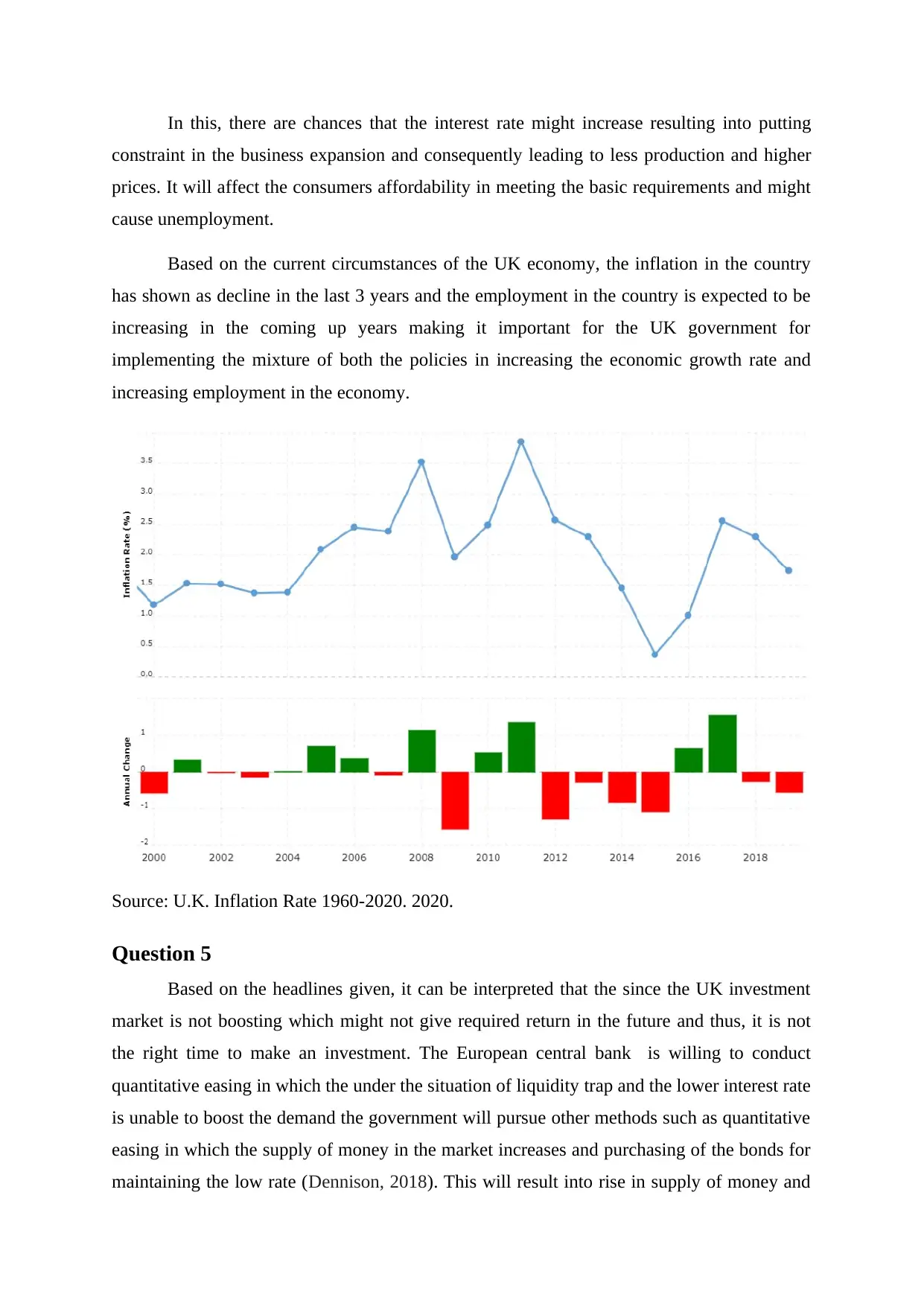
In this, there are chances that the interest rate might increase resulting into putting
constraint in the business expansion and consequently leading to less production and higher
prices. It will affect the consumers affordability in meeting the basic requirements and might
cause unemployment.
Based on the current circumstances of the UK economy, the inflation in the country
has shown as decline in the last 3 years and the employment in the country is expected to be
increasing in the coming up years making it important for the UK government for
implementing the mixture of both the policies in increasing the economic growth rate and
increasing employment in the economy.
Source: U.K. Inflation Rate 1960-2020. 2020.
Question 5
Based on the headlines given, it can be interpreted that the since the UK investment
market is not boosting which might not give required return in the future and thus, it is not
the right time to make an investment. The European central bank is willing to conduct
quantitative easing in which the under the situation of liquidity trap and the lower interest rate
is unable to boost the demand the government will pursue other methods such as quantitative
easing in which the supply of money in the market increases and purchasing of the bonds for
maintaining the low rate (Dennison, 2018). This will result into rise in supply of money and
constraint in the business expansion and consequently leading to less production and higher
prices. It will affect the consumers affordability in meeting the basic requirements and might
cause unemployment.
Based on the current circumstances of the UK economy, the inflation in the country
has shown as decline in the last 3 years and the employment in the country is expected to be
increasing in the coming up years making it important for the UK government for
implementing the mixture of both the policies in increasing the economic growth rate and
increasing employment in the economy.
Source: U.K. Inflation Rate 1960-2020. 2020.
Question 5
Based on the headlines given, it can be interpreted that the since the UK investment
market is not boosting which might not give required return in the future and thus, it is not
the right time to make an investment. The European central bank is willing to conduct
quantitative easing in which the under the situation of liquidity trap and the lower interest rate
is unable to boost the demand the government will pursue other methods such as quantitative
easing in which the supply of money in the market increases and purchasing of the bonds for
maintaining the low rate (Dennison, 2018). This will result into rise in supply of money and
Paraphrase This Document
Need a fresh take? Get an instant paraphrase of this document with our AI Paraphraser
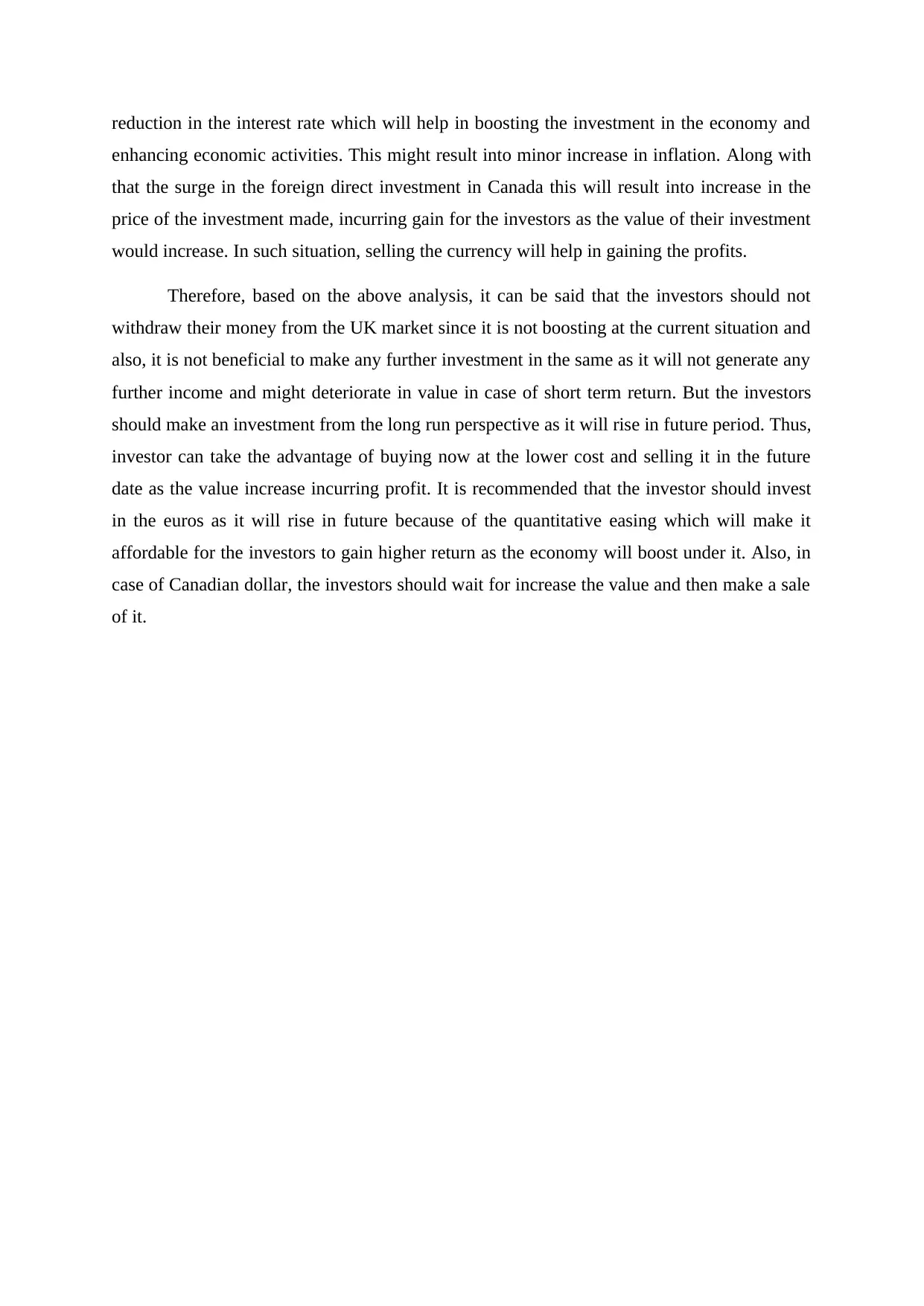
reduction in the interest rate which will help in boosting the investment in the economy and
enhancing economic activities. This might result into minor increase in inflation. Along with
that the surge in the foreign direct investment in Canada this will result into increase in the
price of the investment made, incurring gain for the investors as the value of their investment
would increase. In such situation, selling the currency will help in gaining the profits.
Therefore, based on the above analysis, it can be said that the investors should not
withdraw their money from the UK market since it is not boosting at the current situation and
also, it is not beneficial to make any further investment in the same as it will not generate any
further income and might deteriorate in value in case of short term return. But the investors
should make an investment from the long run perspective as it will rise in future period. Thus,
investor can take the advantage of buying now at the lower cost and selling it in the future
date as the value increase incurring profit. It is recommended that the investor should invest
in the euros as it will rise in future because of the quantitative easing which will make it
affordable for the investors to gain higher return as the economy will boost under it. Also, in
case of Canadian dollar, the investors should wait for increase the value and then make a sale
of it.
enhancing economic activities. This might result into minor increase in inflation. Along with
that the surge in the foreign direct investment in Canada this will result into increase in the
price of the investment made, incurring gain for the investors as the value of their investment
would increase. In such situation, selling the currency will help in gaining the profits.
Therefore, based on the above analysis, it can be said that the investors should not
withdraw their money from the UK market since it is not boosting at the current situation and
also, it is not beneficial to make any further investment in the same as it will not generate any
further income and might deteriorate in value in case of short term return. But the investors
should make an investment from the long run perspective as it will rise in future period. Thus,
investor can take the advantage of buying now at the lower cost and selling it in the future
date as the value increase incurring profit. It is recommended that the investor should invest
in the euros as it will rise in future because of the quantitative easing which will make it
affordable for the investors to gain higher return as the economy will boost under it. Also, in
case of Canadian dollar, the investors should wait for increase the value and then make a sale
of it.
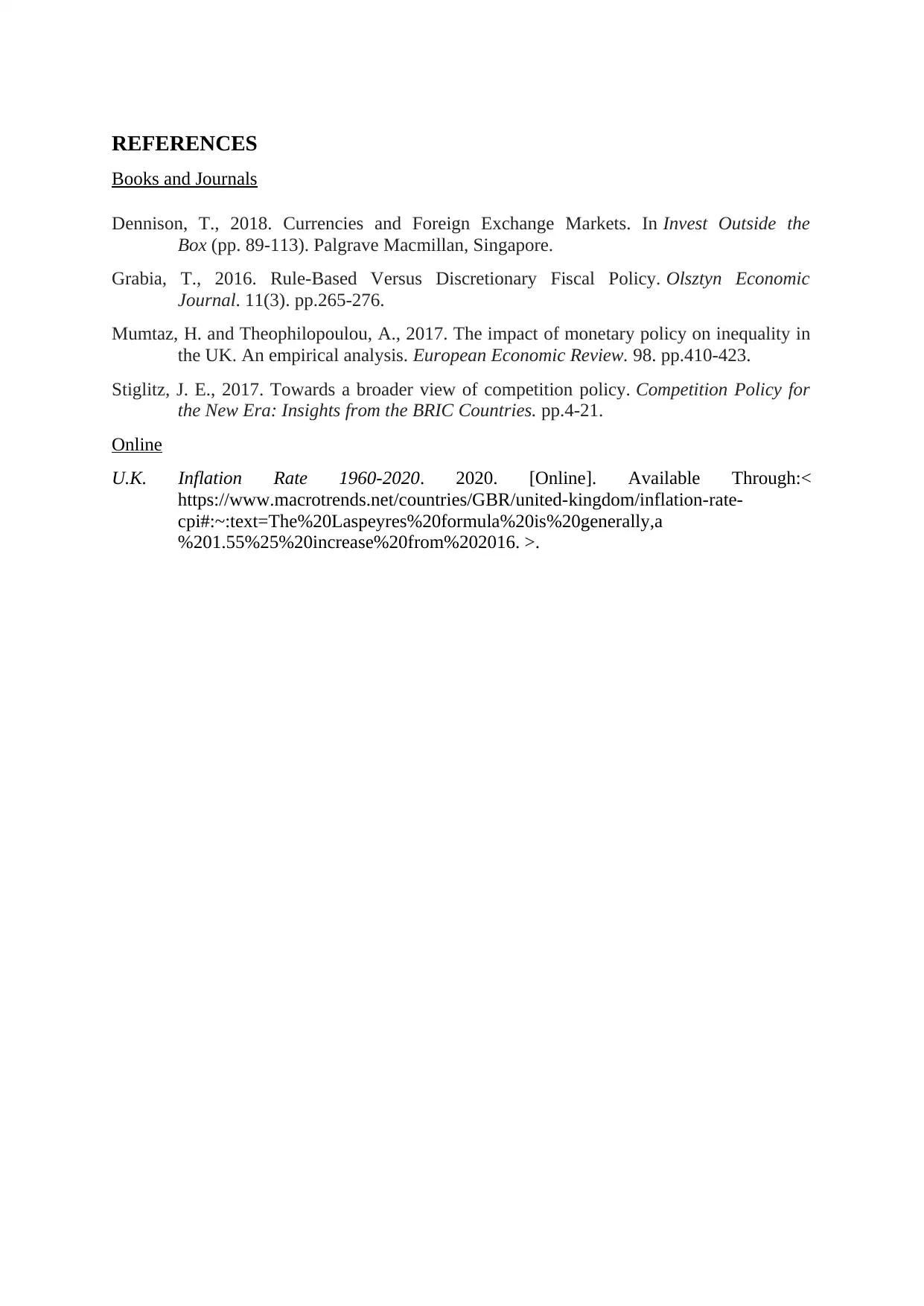
REFERENCES
Books and Journals
Dennison, T., 2018. Currencies and Foreign Exchange Markets. In Invest Outside the
Box (pp. 89-113). Palgrave Macmillan, Singapore.
Grabia, T., 2016. Rule-Based Versus Discretionary Fiscal Policy. Olsztyn Economic
Journal. 11(3). pp.265-276.
Mumtaz, H. and Theophilopoulou, A., 2017. The impact of monetary policy on inequality in
the UK. An empirical analysis. European Economic Review. 98. pp.410-423.
Stiglitz, J. E., 2017. Towards a broader view of competition policy. Competition Policy for
the New Era: Insights from the BRIC Countries. pp.4-21.
Online
U.K. Inflation Rate 1960-2020. 2020. [Online]. Available Through:<
https://www.macrotrends.net/countries/GBR/united-kingdom/inflation-rate-
cpi#:~:text=The%20Laspeyres%20formula%20is%20generally,a
%201.55%25%20increase%20from%202016. >.
Books and Journals
Dennison, T., 2018. Currencies and Foreign Exchange Markets. In Invest Outside the
Box (pp. 89-113). Palgrave Macmillan, Singapore.
Grabia, T., 2016. Rule-Based Versus Discretionary Fiscal Policy. Olsztyn Economic
Journal. 11(3). pp.265-276.
Mumtaz, H. and Theophilopoulou, A., 2017. The impact of monetary policy on inequality in
the UK. An empirical analysis. European Economic Review. 98. pp.410-423.
Stiglitz, J. E., 2017. Towards a broader view of competition policy. Competition Policy for
the New Era: Insights from the BRIC Countries. pp.4-21.
Online
U.K. Inflation Rate 1960-2020. 2020. [Online]. Available Through:<
https://www.macrotrends.net/countries/GBR/united-kingdom/inflation-rate-
cpi#:~:text=The%20Laspeyres%20formula%20is%20generally,a
%201.55%25%20increase%20from%202016. >.
⊘ This is a preview!⊘
Do you want full access?
Subscribe today to unlock all pages.

Trusted by 1+ million students worldwide
1 out of 12
Related Documents
Your All-in-One AI-Powered Toolkit for Academic Success.
+13062052269
info@desklib.com
Available 24*7 on WhatsApp / Email
![[object Object]](/_next/static/media/star-bottom.7253800d.svg)
Unlock your academic potential
Copyright © 2020–2025 A2Z Services. All Rights Reserved. Developed and managed by ZUCOL.





